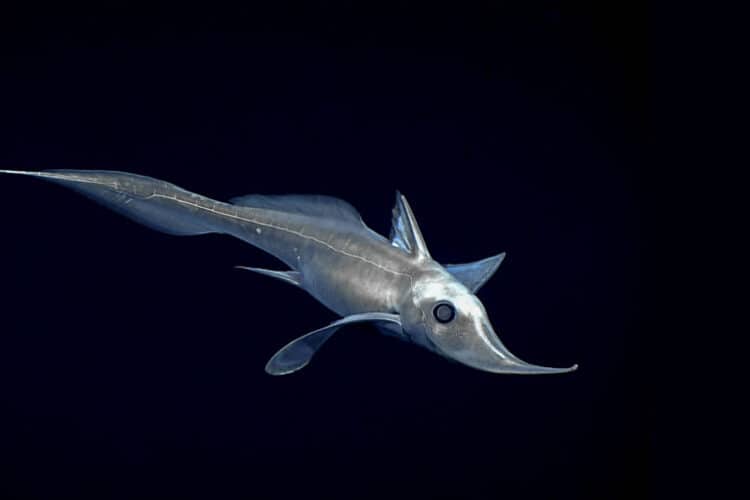One of the biggest jokes in conservation is the Japanese government’s claim to be engaged in “scientific whaling”. All the killing by its harpoon fleet takes place under the guise of “research”, as this is the only justification available, under international rules.
According to Joji Morishita, a diplomat representing Japan at the whaling negotiations, this “research programme” has produced 666 scientific papers.
While we must respect Mr Morishita’s right to invoke the number of the Beast, which may on this occasion be appropriate, during its investigation of Japanese whaling, the International Court of Justice discovered that the entire “research programme” had actually generated just two peer-reviewed papers, which used data from the carcasses of nine whales.

Over the same period, the Japanese fleet killed around 3,600. So what were the pressing scientific questions this killing sought to address? Here are the likely research areas:
How much money can be made from selling each carcass? Does whale meat taste better fried or roasted? To what extent can we take the piss and get away with it?
We are rightly outraged by such deceptions. But while we focus our anger on a country on the other side of the world, the same trick – the mass slaughter of the creatures of the sea under the guise of “scientific research” – is now being deployed under our noses. Our own government, alongside the European commission and other member states, is perpetrating this duplicity.
Fishing in Europe with poisons, explosives and electricity is banned. But the commission has gradually been rescinding the ban on using electricity. It began with one or two boats, then in 2010, after ferocious lobbying by the government of the Netherlands, 5% of the Dutch trawler fleet was allowed to use this technique. In 2012 the proportion was raised to 10%. Eighty-five massive Dutch supertrawlers have now been equipped with electric pulse gear, at a cost of around £300,000 per ship.Advertisement
Over the past few months, the UK government has licensed a further 12 ships. These are registered in the UK and fly the Union flag, which means that they are allowed to fish within our 12-mile limit, but according to some in the fishing industry at least some of the boats have been financed and equipped by Dutch companies.
Pulse trawling, as the technique is known, uses electricity to flush flatfish or shrimp out of the sediments in which they hide. The electric shock makes them convulse and flip upwards, into the net. Electric fishing can greatly increase the catch of these species.
The industry and the Dutch and British governments claim that this technique is less damaging than conventional beam trawling. That is not exactly a high bar. If they needed to market influenza, they would doubtless argue that it’s better than bubonic plague.
Beam trawling is a perfectly designed system for maximum environmental destruction. It rips up not just the life on the surface of the seabed, but also, through the use of “tickler chains” (actually massive scouring devices, whose purpose is to extract buried flatfish), the underlying sediments.
So it is certainly conceivable that pulse trawling causes less damage than the full-spectrum ecocide delivered by beam trawling. But unfortunately we have, at present, no way of knowing.
There has so far been no serious effort to discover what the impacts of repeated electric shocks might be on any of the animal communities of the sea: those that live in the open water, on the seabed or under it. The tiny amount of research conducted so far has involved just a few species in fish tanks and, as far as I can discover, just one vague, poorly-designed and inconclusive study at sea.
Yet these 97 ships (85 Dutch, 12 “British”) have been licensed to operate across the entire southern North Sea: in other words, from Kent to Schleswig-Holstein, Edinburgh to Jutland.Pulse fishing trials are scientifically validLetters: Initial trials of pulse fishing would appear to demonstrate a potential answer to all of the challenges that beset traditional trawling and dredging methodsRead more
Outrageously, this includes the region’s Special Area of Conservation: Dogger Bank. Special Areas of Conservation are supposed to confer the highest level of protection of any European wildlife sites. Thanks to a veto by the Dutch government, every part of the Dogger Bank and its remarkable habitats remains open to beam trawling – and now electric fishing – and this area is ripped up on a daily basis.
By 2014 the pulse trawlers were already operating across the whole southern North Sea, at greater intensity even than the traditional beam trawling fleet, with the exception of the seas within the 12-mile national limits around Britain, Germany and Denmark.
With the licensing of the 12 “British” boats, our inshore waters will now also be exploited, including the two Special Areas of Conservation in England’s North Sea territorial waters: the North Norfolk sandbanks and the Haisborough, Hammond and Winterton reefs and banks, also off the coast of Norfolk.
Objections by groups such as the Marine Conservation Society, which have begged the government and the commission to ensure that protected sites are actually, er, protected, have simply been brushed aside.
So what possible justification does the commission give for permitting this mass deployment of an untested technology? Oh yes. It’s a “trial” for the purpose of “scientific research”. The commission tells me that the trial is “envisaged to last for five years.”
The Dutch government explains that this “research programme” will study “the selectivity of the pulse trawl and the environmental benefits of leaving the seabed undamaged”. Note that it says nothing about the possible downsides. It already assumes that the technique is beneficial and undamaging.
Given that the experimental area extends to the whole of the southern North Sea, what kind of an experiment is this? What’s the hypothesis? What’s the methodology? Where’s the control? How will the results be measured? Given that there appear to be no answers to these questions, let me propose some.
Hypothesis: That if pulse trawling is rolled out across the entire region before meaningful trials are conducted, the political momentum for its continued deployment – whatever the impacts may be – will become unstoppable.
Methodology: Equip 97 ships run by powerful corporations with gear worth £300,000 per boat to create what is, in effect, an irreversible decision. Fish everywhere to create a precedent and lobby and co-opt as many politicians as you can.
Results: Squillions of euros in the bank (preferably an offshore account) for Big Fish, while the small fishers with whom it competes are driven to the wall. Effects on the ecosystem: sorry, what was that?
Conclusion: The commission and its member governments are staffed by incompetent, gullible numpties, incapable of defending either the natural world or the public interest.
But if the commission is incompetent, careless and useless (who knew?), at least it’s not relying on the misleading and selective statements with which the British government seeks to justify the policy.
When asked what conditions it had attached to its licensing of “British” vessels to use electric fishing, the UK’s environment department, Defra, told me that these included “ensuring electric trawling is only allowed in certain areas”. “Certain areas” turns out to mean, yes, the entire southern North Sea, including the three Special Areas of Conservation.
The government went on to claim that permission would be rescinded if a scientific assessment established that harm was being done, but given that there is no credible means of assessment, it’s impossible to see how this could happen.
The government then made a statement that the scientific papers I have seen suggest is simply wrong. “Currently studies indicate that pulse stimulation does not result in an increased mortality in sole, cod, brown shrimp and rag-worm. No mortality or spinal injury had been found in plaice, sole, cod, for example.”
There is plenty of evidence to suggest that this is incorrect. Among the few studies of the impacts of pulse trawling conducted so far is one showing that between 50 and 70% of large cod that come close to a passing electrode at realistic field strengths suffer fractured vertebrae. The cracking of their spinal columns through electric shocks also creates internal haemorrhages.

Another trial showed that shrimp exposed to electric shocks have a significantly higher risk of subsequent infection with a virus. A further study showed a “statistically significant lower survival” rate for ragworm.
As for flatfish like sole and plaice, we simply have no idea. In 2012, a small-scale fisherman in Kent told the Sunday Times that the areas through which the pulse trawlers have passed are “a graveyard. What they don’t catch, they annihilate. Virtually everything is dead.” Another reported “You can have as many as 50 dead Dover sole in an hour and a half. We would hardly ever see a dead fish before. It is a waste of time going to that area now. It stinks of dead fish.”
And the rest of the ecosystem? Who knows? Some research finds that pulse trawlers have a lower bycatch (species they do not intend to take) than beam trawlers. This may be true, and it would scarcely be difficult, given the extraordinary amount of damage wreaked by conventional methods. But a study of pulse trawlers fishing for shrimp revealed “considerably higher bycatch rates for some species, compared to traditional beam trawls with sieve nets.”
Electric fishing allows boats to catch flatfish on muddy bottoms, which is difficult with conventional beam trawling, so it is likely to spread fishing damage into some of the few areas that were not previously being repeatedly wrecked. Pulse trawlers extracting flatfish still use a thick cable (the footrope) that drags across the bottom, so the physical damage they cause remains extremely high, while the electrical damage is unknown.
Pulse trawling allows shrimp fishers to operate in clear water and during daylight, when shrimp are inaccessible to conventional fishing, so this could greatly increase the catch rate. Amazingly, there are no limits on the amount of shrimp that can be taken in the North Sea. When the same technologies were deployed in the East China Sea, they led to the collapse of the fishery, with the result that electric fishing is now banned in China.
As for the effects of repeated exposure to electric shocks on the animals of the sea, the impacts these might have on their ability to breed, implications for the survival of long-lived species, the long-term damage that might be done to species that detect their prey through electro-reception (such as sharks and rays) and a host of other such questions, there is simply no data at all. Studies in freshwater suggest that electric shocks can be highly damaging to both fish eggs and fish embryos, but we have no idea whether the same effect occurs in salt water.
Given that there are no controls on this “experiment”, no areas from which the fishing boats are excluded, no methodology and no obvious measurement parameters, the only way in which we are likely to discover whether or not the technique is damaging is through the collapse of the marine ecosystem across the entire fished area. How else could it be determined?
What this issue highlights is the absence of meaningful protection for the wildlife of the sea.
Astonishingly, fishing, like farming, is entirely exempt from the environmental impact assessments that every other industry must undertake. A friend who works for the offshore wind industry tells me that the impact assessment for a large marine wind farm runs to about 20,000 pages, even though windfarms appear to have almost no impact on subsea life except a positive one, by providing places on which wildlife can anchor and offering some protection from trawlers.
To conduct an experimental trawl to discover what lives on the seafloor where a wind farm is planned, my friend must submit an exhaustive application for a licence specifying where and when and for how long the trawl will be conducted. He hires a trawler and crew to do the work. When the job is done, they wave goodbye, drop the nets back over the side and carry on fishing, without the need for any permission at all.
In other words, fishing in EU waters is smash and grab piracy of the most primitive kind, unregulated, unlicensed, and controlled only by the crudest possible method: namely the setting of quotas.
Everything wrong that takes place on land is multiplied by ten at sea, because politicians reckon that what the eye don’t see the heart don’t grieve. It’s time that changed.
Support the Marine Conservation Society, Greenpeace, Oceana, Save Our Seas, Blue Marine, Sea Shepherd or one of the other groups desperately fighting to protect the life of the seas, and let them know you care.
This article was first published by The Guardian on 09 Feb 2015.







Leave a Reply